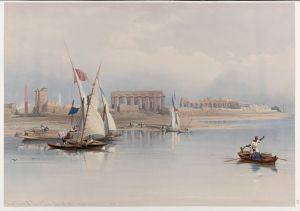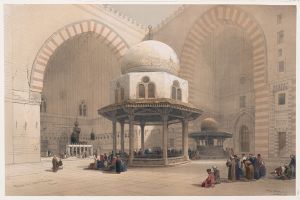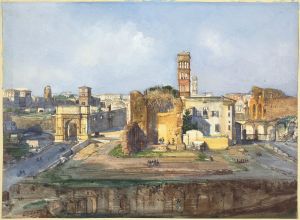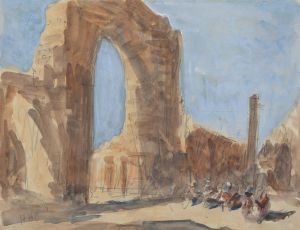
Pompey’s Pillar, Alexandria.
A hand-painted replica of David Roberts’s masterpiece Pompey’s Pillar, Alexandria., meticulously crafted by professional artists to capture the true essence of the original. Each piece is created with museum-quality canvas and rare mineral pigments, carefully painted by experienced artists with delicate brushstrokes and rich, layered colors to perfectly recreate the texture of the original artwork. Unlike machine-printed reproductions, this hand-painted version brings the painting to life, infused with the artist’s emotions and skill in every stroke. Whether for personal collection or home decoration, it instantly elevates the artistic atmosphere of any space.
"Pompey’s Pillar, Alexandria" is a painting created by the Scottish artist David Roberts in the 19th century. Roberts, renowned for his detailed and romanticized depictions of architectural and historical landmarks, painted this work as part of his extensive travels through the Middle East and North Africa. The painting showcases Pompey’s Pillar, a famous Roman triumphal column located in Alexandria, Egypt.
Pompey’s Pillar is one of the most prominent ancient monuments in Alexandria and stands as a testament to the city’s rich historical and cultural heritage. The column, made of red Aswan granite, rises approximately 27 meters (88 feet) high and is believed to have been erected in honor of the Roman Emperor Diocletian in 297 AD. It is the largest Roman column outside of Rome and Constantinople and remains a significant symbol of Alexandria’s ancient past.
David Roberts visited Egypt during his travels from 1838 to 1839, a journey that formed the basis for many of his most celebrated works. His paintings and lithographs from this period were widely admired for their accuracy and attention to detail, as well as their ability to capture the grandeur and atmosphere of the locations he depicted. "Pompey’s Pillar, Alexandria" reflects Roberts’ skill in portraying architectural structures within their natural and urban settings, often with dramatic lighting and a sense of scale that emphasizes their historical significance.
The painting features the column prominently, surrounded by the ruins and landscape of Alexandria. Roberts often included figures in his works to provide a sense of scale and to evoke the daily life of the regions he visited. His artistic style combined realism with a romanticized vision of the exotic, which appealed to European audiences of the time who were fascinated by the ancient and the unfamiliar.
David Roberts’ works, including "Pompey’s Pillar, Alexandria," were published as lithographs in his monumental series The Holy Land, Syria, Idumea, Arabia, Egypt, and Nubia, which was released between 1842 and 1849. This series played a significant role in shaping Western perceptions of the Middle East and North Africa during the 19th century.
Today, Roberts’ paintings and lithographs are valued for their historical significance and artistic merit. They provide a visual record of many sites as they appeared in the 19th century, offering insights into both the physical condition of these landmarks at the time and the ways in which they were perceived by European travelers.










![Ruins of Karnack [Karnak].](/imgs/217533/s/david-roberts-ruins-of-karnack-karnak-f5b9f9ff.jpg)
![Ruins. Temple on the Island of Biggeh [Bîga, Bîjah], Nubia.](/imgs/217537/s/david-roberts-ruins-temple-on-the-island-of-biggeh-biga-bijah-nubia-1cd1f41d.jpg)
![Group of Nubians, Wady Kardasey [sic] [Qirtâsî].](/imgs/217579/s/david-roberts-group-of-nubians-wady-kardasey-sic-qirtasi-c64109d2.jpg)





